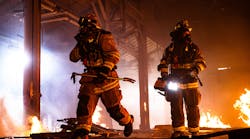This article’s headline should immediately set off an alarm for the fire service. There is some confusion and misinformation that funding may no longer be needed for the replacement of land mobile radio (LMR) infrastructure and/or LMR and portable radios. This confusion is often caused by the expanding use and reference of Voice over IP (VoIP), Voice over LTE (VoLTE) or Radio over IP (RoIP) through the use of apps/software on smartphones, tablets and computers over a broadband or WiFi network.
The most significant distinction is that the public safety LMR networks are designed for a high degree of reliability and redundancy and that the radios (mobile and portable) can communicate radio to radio in the absence of a network. In other words, even if the public safety radio network fails, the public safety radios used in the field will continue to be able to communicate with other radios regardless. The ability of radios to communicate between each other in the absence of a network is the primary distinguishing characteristic of “Mission-Critical Voice” communications. At best, broadband devices will serve as an enhancement to public safety LMR systems. Based on the “Mission-Critical Voice” requirements alone, smartphones, tablets or computers cannot replace LMR infrastructure, mobile and portable radios in mission-critical environments for some time to come.
Fire service ergonomics and environments
Public safety radios (especially portable radios) have been designed by the manufacturers to meet the fire service ergonomic needs to operate in harsh environments (blowing rain, extreme cold/heat, blowing sand, explosive atmospheres, etc.) and withstand drops and are designed with large control knobs. These large knobs, combined with audio acknowledgement, allow for the control of the portable radio while a firefighter is operating in a zero visibility environment.
LCDs, LEDs or smartphone touch screen displays alone for the control of such portable radio functionality have proven to be ineffective and unsatisfactory for firefighting environments. Most importantly, smartphones cannot and should not be represented as an absolute substitution for land mobile and/or portable radios, especially in the firefighting environment.
“Mission-Enhanced Voice” communications
In order to put things into the right perspective, there needs to be an expanded definition of public safety voice communications. Now that “Mission-Critical Voice” has been clearly defined, it is time to explore what can be called “Mission-Enhanced Voice” communications. “Mission-Enhanced Voice” communications involves technologies that enhance the “Mission-Critical Voice” LMR system. This is how the VoIP, VoLTE or RoIP play an important role.
Generally, a gateway communications device is used to interface IP (Internet Protocol) broadband devices with an existing land mobile radio system. Once the interface is in place, IP devices such as smartphones, tablets and computers can operate and communicate with LMR mobiles and portables. While the functionality is very similar, it is important to reemphasize that these IP or broadband devices will no longer be able to communicate to other public safety responders should either the broadband network or LMR system fail.
The benefits of “Mission Enhanced Voice” communications is that it enables a plethora of devices that can now connect to the traditional LMR system, which extends the number of agencies and/or subject matter experts that may be needed to address significant events/incidents. In this way, it greatly enhances communications interoperability to virtually any agency or any person needed for any given conversation. And because this enhanced voice communications is Internet based, it expands the geographic area of the communications footprint to anywhere in the world where there is Internet connectivity (3G, 4G, WiFi, LTE, etc.).
Smartphones, tablets and computers
Smartphones, tablets and computers can access a communications gateway through a simple client application. Simply open the app and you can see a radio-like display with “transmit” buttons that operate similar to any other push-to-talk device. The difference is that the voice communication transmitted from the smartphone is transferred and simultaneously transmitted over the LMR system. This is a game changer as to what and how devices can be used to communicate over public safety LMR systems and it means that smartphones and tablets, which are being carried by almost everyone, can now be used for public safety communications.
In addition to the ability to conduct voice communications over public safety LMR systems, these VoIP apps can also allow voice operation separately and encrypted directly between smartphones over the broadband network. These communications can be established as one to one or one to many (groups). This also allows communications to occur over the Internet and can create a parallel communications network, which can provide a certain level of redundancy and reduce lower-priority radio traffic over the LMR system (similar to how the Nextel network was used by many public safety departments).
Additional capabilities for mobile devices
Several other features of these apps on smartphones and tablets are the capabilities of sharing digital images, streaming video in real time and geospatial location tracking through the use of the device’s internal global positioning system (GPS).
This new capability also requires the implementation of standard operating procedures (SOPs) or standard operating guides (SOGs) that provide the necessary oversight as to how, when and by whom this mission-enhanced voice is to be used. While the added accessibility can be a plus, the absence of appropriate policies and procedures can and will very likely create chaos. It is important to remember that radio interoperability is defined as the ability to communicate with other public safety responders when needed, where needed and as authorized.
There have also been discussions on the development of a hybrid combination of land mobile radio portables with broadband functionality. This would provide a device that could communicate over the traditional LMR system but also take advantage of the broadband features.
Regional public safety pilot project
A pilot project has been underway in the Charlottesville, VA, area with multiple public safety departments and is an expansion of the Commonwealth of Virginia’s Commonwealth’s Link to Interoperable Communications (COMLINC) program. Smartphones can connect to the existing regional public safety Motorola digital trunked radio system through the use of a Radio Interoperability Operating System (RIOS) gateway. While this project is still in the pilot stage, it shows great promise to public safety responders using current commercial wireless networks like Verizon, Sprint, U.S. Cellular, AT&T and T-Mobile. The future success is even more promising as the First Responder Network Authority (FirstNet) moves forward.
FirstNet, as stated on the FirstNet website, has been legislatively, “obligated by Congress to ensure the building, deployment and operation of the nationwide public safety broadband network.” FirstNet has repeatedly stated that the primary focus of this nationwide broadband network is on data communications and specifically not “Mission-Critical Voice” communications and not the replacement of public safety LMR systems.
—Charles Werner






